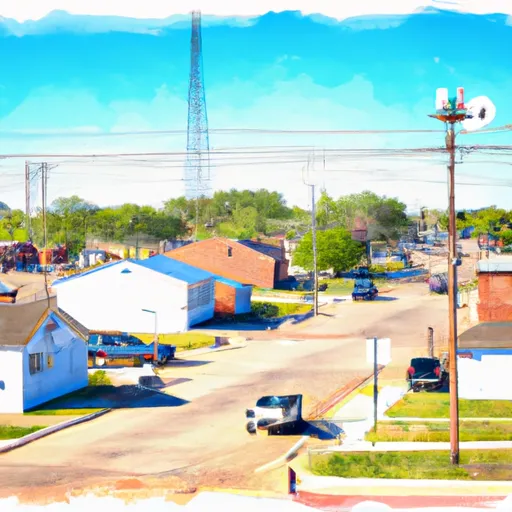-
 Snoflo Premium
Snoflo Premium
Get unlimited access to all our content
With no Ad interruptions! - Start Your Free Trial Login with existing account
Sawyer
Eden Index
Climate
8.1
•
Recreation
3.4
•
Community
•
Safeguard
4.4/10

Sawyer, Oklahoma, located in the southeastern part of the state, experiences a humid subtropical climate. Summers are hot and humid, with temperatures averaging in the high 80s to mid-90s Fahrenheit. Winters are mild, with temperatures ranging from the mid-30s to mid-50s Fahrenheit. The area receives moderate rainfall throughout the year, with the wettest months being May and October.
Hydrologically, Sawyer benefits from its proximity to the Red River, which flows along its western border. The river not only provides a water source but also offers opportunities for fishing, boating, and other water-based activities. Additionally, Sawyer is dotted with smaller lakes and ponds, including Hugo Lake and Sardis Lake, which are renowned for their fishing opportunities.
Outdoor enthusiasts in Sawyer have plenty of recreational options. The area is surrounded by lush forests and rolling hills, making it ideal for hiking, camping, and wildlife observation. Hunting is also popular in the region, with deer, turkey, and small game being plentiful. The nearby Kiamichi Mountains provide additional opportunities for hiking, horseback riding, and exploring scenic trails.
Overall, Sawyer, Oklahoma offers a favorable climate, varied hydrology constituents, and abundant outdoor recreation opportunities for nature lovers and adventure seekers.
What is the Eden Index?
The Snoflo Eden Index serves as a comprehensive rating system for regions, evaluating their desirability through a holistic assessment of climate health, outdoor recreation opportunities, and natural disaster risk, acknowledging the profound impact of these factors on livability and well-being.
Climate Health Indicator (CHI): 8.1
Sawyer receives approximately
1213mm of rain per year,
with humidity levels near 84%
and air temperatures averaging around
17°C.
Sawyer has a plant hardyness factor of
8, meaning
plants and agriculture in this region tend to thrive here all year round.
By considering the ideal temperature range, reliable water supplies, clean air, and stable seasonal rain or snowpacks, the Climate Health Indicator (CHI) underscores the significance of a healthy climate as the foundation for quality living.
A healthy climate is paramount for ensuring a high quality of life and livability in a region, fostering both physical well-being and environmental harmony. This can be characterized by ideal temperatures, reliable access to water supplies, clean air, and consistent seasonal rain or snowpacks.
Weather Forecast
Streamflow Conditions
Red-Little
Area Rivers
Red-Little
Snowpack Depths
Red-Little
Reservoir Storage Capacity
Red-Little
Groundwater Levels
Recreational Opportunity Index (ROI): 3.4
The Recreational Opportunity Index (ROI) recognizes the value of outdoor recreational options, such as parks, hiking trails, camping sites, and fishing spots, while acknowledging that climate plays a pivotal role in ensuring the comfort and consistency of these experiences.
Access to outdoor recreational opportunities, encompassing activities such as parks, hiking, camping, and fishing, is crucial for overall well-being, and the climate plays a pivotal role in enabling and enhancing these experiences, ensuring that individuals can engage in nature-based activities comfortably and consistently.
Camping Areas
| Campground | Campsites | Reservations | Toilets | Showers | Elevation |
|---|---|---|---|---|---|
| Governor Jim Hogg RV Park - Quitman | None | 394 ft | |||
| Fish Hawke Point | None | 359 ft | |||
| Lake Jacksonville Campground | 17 | 427 ft | |||
| Lake Holbrook Park - South | None | 379 ft | |||
| Lake Holbrook Park - West | None | 383 ft | |||
| Lake Quitman Park | None | 414 ft | |||
| Rusk - Palestine Park | 71 | 447 ft | |||
| Tyler State Park | 104 | 637 ft | |||
| Lake Hawkins County RV Park | 50 | 366 ft | |||
| Lake Winnsboro North Park | 15 | 441 ft |
Catastrophe Safeguard Index (CSI):
The Catastrophe Safeguard Index (CSI) recognizes that natural disaster risk, encompassing floods, fires, hurricanes, and tornadoes, can drastically affect safety and the overall appeal of an area.
The level of natural disaster risk in a region significantly affects safety and the overall livability, with climate change amplifying these risks by potentially increasing the frequency and intensity of events like floods, fires, hurricanes, and tornadoes, thereby posing substantial challenges to community resilience and well-being.
Community Resilience Indicator (CRI):
The Community Resilience Indicator (CRI) recognizes that education, healthcare, and socioeconomics are crucial to the well-being of a region. The CRI acknowledges the profound impact of these elements on residents' overall quality of life. By evaluating educational resources, healthcare accessibility, and economic inclusivity, the index captures the essential aspects that contribute to a thriving community, fostering resident satisfaction, equity, and social cohesion.

